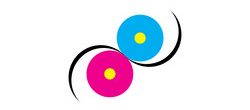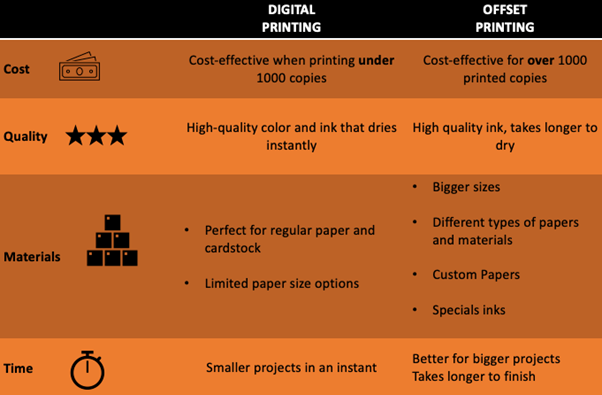When it comes to printing projects, choosing the right printing method is crucial for achieving the best results. Two popular options that are often compared are offset printing and digital printing. In this article, we will explore the differences between these two printing methods and help you determine which one is right for your project.
2: What is Offset Printing?
Offset printing is a traditional printing method that has been widely used for many years. It involves transferring ink from a metal plate to a rubber blanket and then onto the printing surface. This process is ideal for large volume printing, as it offers high-quality and cost-effective results.
: Advantages of Offset Printing
1. Superior image quality: Offset printing produces sharp and vibrant images, making it perfect for projects that require high-resolution printing.
2. Pantone color matching: Offset printing allows for precise color matching, ensuring consistent and accurate results.
3. Cost-effective for large volumes: The setup costs for offset printing can be high, but the cost per unit decreases significantly for large print runs.
4. Wide range of paper options: Offset printing supports various paper types and weights, giving you more flexibility in choosing the right paper for your project.
: Limitations of Offset Printing
1. Longer setup time: Offset printing requires the creation of printing plates, which can add extra time to the production process.

2. Not suitable for short print runs: Due to the setup time and cost, offset printing is not cost-effective for small quantities.
3. Limited customization options: Offset printing is less flexible when it comes to individualized prints or variable data printing.
3: What is Digital Printing?
Digital printing is a modern printing method that utilizes digital files to directly print the desired content onto the printing surface. It offers quick turnaround times and is ideal for small to medium print runs.
: Advantages of Digital Printing
1. Fast turnaround: Digital printing eliminates the need for plate creation, resulting in shorter setup times and faster production.
2. Cost-effective for small quantities: Since there are no setup costs involved, digital printing is more affordable for short print runs.
3. Variable data printing: Digital printing allows for personalized prints with individualized information, such as names or addresses.
4. Easy file modification: Digital files can be easily edited and modified, making last-minute changes hassle-free.
: Limitations of Digital Printing
1. Limited color accuracy: Digital printing may not achieve the same level of color accuracy as offset printing, especially when it comes to Pantone color matching.
2. Higher cost per unit for large volumes: While digital printing is cost-effective for small quantities, the cost per unit increases for larger print runs.
3. Limited paper options: Digital printing is more compatible with standard paper types, and special finishes may not be achievable.
4: Which Printing Method Should You Choose?
The choice between offset printing and digital printing depends on several factors:
: Quantity
If you require a large volume of prints, offset printing is the more cost-effective option. However, for small quantities, digital printing is the way to go.
: Quality
If achieving the highest image quality and color accuracy
Summary:
Offset printing is a traditional printing technique that involves transferring ink from a plate to a rubber blanket before applying it to the printing surface. It offers high-quality and consistent results, making it ideal for large print runs. On the other hand, digital printing utilizes advanced technology to produce prints directly from digita this link l files. It is best suited for short print runs and offers quick turnaround times, customization options, and variable data printing capabilities.
- Q: What is offset printing?
- A: Offset printing is a traditional printing method that transfers ink from a metal plate to a rubber blanket, which then applies the ink onto the printing surface.
- Q: What are the advantages of offset printing?
- A: Offset printing offers high image quality, precise color reproduction, and the ability to print on a wide range of materials. It is cost-effective for large print runs.
- Q: What is digital printing?
- A: Digital printing is a modern printing method that directly transfers digital files onto the printing surface. It does not require the use of plates.
- Q: What are the advantages of digital printing?
- A: Digital printing allows for quick turnaround times, variable data printing, cost-effectiveness for small print runs, and the ability to easily make changes or updates to the artwork.
- Q: Which printing method is more suitable for small print runs?
- A: Digital printing is more suitable for small print runs due to its cost-effectiveness and ability to easily accommodate variable data printing.
- Q: Which printing method is more suitable for large print runs?
- A: Offset printing is more suitable for large print runs as it becomes more cost-effective with higher quantities.
- Q: Which printing method provides higher image quality?
- A: Offset printing generally provides higher image quality and better color accuracy compared to digital printing.
- Q: Can digital printing accommodate last-minute changes to the artwork?
- A: Yes, digital printing allows for easy and quick changes to the artwork, making it ideal for projects that require frequent updates or customization.
- Q: Which printing method offers more material options?
- A: Offset printing offers a wider range of material options, including specialty papers and finishes.


